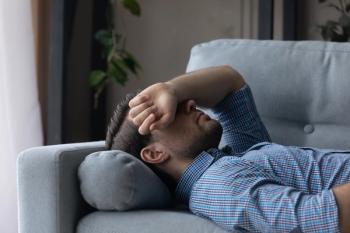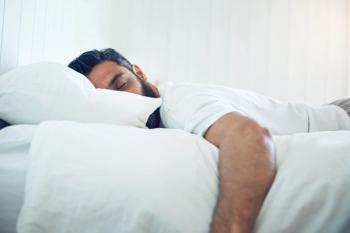
Acknowledging Preindustrial Patterns of Sleep May Revolutionize Approach to Sleep Dysfunction
Acknowledging Preindustrial Patterns of Sleep May Revolutionize Approach to Sleep Dysfunction
Once again your patient-an accountant and tax specialist-is complaining about restless sleep. More nights than not, he awakens at about 2 am. An hour goes by, sometimes two, before he returns to sleep. You've prescribed 4 different hypnotic agents. Each gave the same unsatisfactory result. For 2 weeks your patient got the 8 hours of uninterrupted sleep both he-and you-seek, but the old pattern returns. Following your instructions, he avoids caffeine, does not exercise after 6 pm, and confines his activities in bed to sleep. Although diligent, his efforts are to no avail. You refer him to a sleep laboratory. The results are entirely consistent with what he has been telling you. In the sleep lab, he falls asleep at 11 pm, wakes at 2:30 am, returns to sleep at 4 am, and finally awakens at 7:30 am. He does not have sleep apnea, restless legs syndrome, or depression.Your patient seems more concerned about what he perceives as restless sleep as the years go on. You've suggested that when he awakes, he should read until he feels sleepy, but instead he spends his awake-time worrying about why he can't sleep and how his interrupted sleep will affect his work. His awake-time seems to be increasing. Indeed, he insists that his daytime concentration isn't as good as it once was.At a drug company-sponsored dinner, you learn that interrupted sleep is among the most common sleep problems. You also learn that a new hypnotic medication promises to be better than previous ones at providing continuous "sleep-consolidated sleep," as the speaker called it. To her credit, the speaker did not shy away from the fact that the new hypnotic works by enhancing gamma-aminobutyric acid transmission, just like the older hypnotic-class drugs.Do you subject your patient to yet another drug trial, this time with a more expensive, albeit not very different, agent? Given your patient's misery about his sleep problem and given that you've exhausted the available options, such a course is not unreasonable. However, a recent discovery-not from a drug company laboratory or a university research program but from a historian-suggests that there may be another, very different way to relieve your patient's problem.SLEEP IN TIMES PASTIn the course of gathering information for his book, At Day's Close: Night in Times Past, which is about night in preindustrial times, A. Roger Ekirch, professor of history at Virginia Polytechnic Institute in Roanoke, uncovered the fact that in preindustrial times before artificial illumination was widely used, persons typically slept in 2 shifts.1 They called the shifts "first sleep" and "second sleep." In those times, sleep was more closely associated with sunset and sunrise than it is now. Within an hour or so after sunset, persons retired to bed, slept for about 4 hours and then woke up. They remained awake for a few hours and then returned to sleep at about 2 am for another 4 hours or so.Written records from before the first century onward indicate that the period between first and second sleep afforded persons a chance for quiet contemplation, but persons also rose from bed during this interval and did household chores or visited with family and friends. Although diaries, court documents, and literature of the time indicate that this sleep pattern was widely acknowledged, this bit of history had been lost until the debut of Ekirch's work.The pattern of sleep he describes as the norm in days past is no longer the norm in developed countries where artificial light extends the day. Anthropologists, however, have observed a similar pattern of segmented sleep among some contemporary African tribes,1 such as the Tiv of central Nigeria, who even refer to their customary sleep patterns as first sleep and second sleep, just as the early Europeans did.SHIFT SLEEP NORMALSeveral lines of evidence suggest that this archaic sleep pattern may, in fact, be the natural sleep pattern for humans-the one most in tune with our inherent circadian rhythms and the natural environment. In the early 1990s, a team headed by Thomas A. Wehr, MD, then a sleep researcher at the National Institute of Mental Health (NIMH), reported that when 8 healthy men had their light/dark schedule shifted from their customary 16 hours of light and 8 hours of dark to a schedule in which they were exposed to natural and artificial light for 10 hours each day and confined to a dark room for 14 hours each night (durations of light and dark similar to the natural durations of day and night in winter), they developed a sleep pattern similar to that followed in the preindustrial era.2,3The study participants slept in 2 sessions of about 4 hours each separated by 1 to 3 hours of quiet wakefulness. Subjects usually woke from their first shift of sleep during a period of rapid eye movement (REM). The second shift was usually lighter than the first, with less stage 4 (deep) and more REM sleep.4Wehr, now Scientist Emeritus at the NIMH, conjectures that our current sleep pattern, in which we fall asleep rapidly and expect to sleep-and often do-for an uninterrupted 7 or 8 hours, may be an artifact of both chronic sleep deprivation and artificial light. When the participants in his experiments shifted from the 16-hour "days" and 8-hour "nights" customary for them (and for others in developed countries, who depend on artificial light) to the "natural winter" conditions of his experiment, they first slept for 11 hours and then began to sleep for an average of 8.9 hours, as compared with 7.2 hours under ordinary conditions.3These and other data5 suggest that our current schedules do not allow us the sleep that we require. Wehr also observed that when given 14 hours of darkness, it took participants in bed rest about 2 hours to fall asleep compared with 15 minutes under usual conditions.4 He speculates that under our current conditions, we may fall asleep so quickly because we are chronically sleep-deprived. Natural sleep, Wehr suggests, particularly during relatively long periods of darkness, is characterized by a long sleep latency "interspersed with periods of wakefulness."4The discoveries of Ekirch and Wehr raise the possibility that segmented sleep is "normal" and, as such, these revelations hold significant implications for both understanding sleep and the treatment of insomnia. However, most sleep specialists are unaware of these findings, in part because these discoveries about sleep patterns have not been widely disseminated.Ekirch's book received a good number of deservedly positive reviews but it is, after all, history, and is not at the top of sleep specialists' reading lists. Wehr's sleep research is well known to sleep specialists, but the thrust of his work has been on uncovering the mechanisms governing sleep. His discovery of segmented sleep was an unexpected, incidental finding from a study that examined the influence of photoperiods on sleep and melatonin.2CHALLENGING CURRENT THOUGHTAlso working against the clinical application of these findings is the extent to which they fly in the face of current thinking. The general public seems to regard 7 to 8 hours of unbroken sleep as a birthright; anything less means that something is awry. Sleep specialists share this assumption. Todd Arnedt, PhD, clinical assistant professor of psychiatry and neurology at the University of Michigan and a sleep researcher and clinician, acknowledges that the conventional approach to patients who cannot maintain sleep is to consolidate sleep. In being informed about Ekirch's and Wehr's discoveries about sleep patterns, Arnedt commented that the conventional approach taken to the management of sleep disorders might not be the best one. He pointed out that patients' perceptions about the quality of their sleep determine how they actually do sleep to some extent.Arnedt tries to have his patients with insomnia "stop seeing their sleep as problematic." If they can accomplish this, sleep loss becomes more tolerable. The reasoning is that if patients perceive interrupted sleep as normal, they might experience less distress when they awake at night and fall back to sleep more easily.Wehr agrees. He writes: "When modern humans find that their sleep is . . . interrupted by periods of wakefulness . . . they regard it as being disordered . . . an alternative explanation could be that a natural pattern of human sleep is breaking through into an artificial world in which it seems unfamiliar and unwelcome."4 "Waking up after a couple of hours may not be insomnia," he says. "It may be normal sleep."Mary Carskadon, PhD, a sleep researcher at Brown University, did not know of Ekirch's historical findings but did know of the segmented sleep pattern discovered by Wehr and that some animals also take "two sleeps." Considering these observations, she speculated that "maybe the brain can't keep you asleep for prolonged periods." She wondered whether the archaic sleep pattern had a functional purpose. Like Ekirch, Carskadon believes that the change in sleep pattern "highlights something humanity might have lost in the hurly-burly times we live in today."Much as we may envy the more relaxed sleep pattern of our forebears, we are unlikely to revert to it. As Carskadon, however, notes that it would benefit patients to tell them that such a sleep pattern may be natural.REFERENCES1. Ekirch AR. At Day's Close: Night in Times Past. New York: WW Norton; 2005.2. Wehr TA. In short photoperiods, human sleep is biphasic. J Sleep Res. 1992;1:103-107.3. Barbato G, Barker C, Bender C, et al. Extended sleep in humans in 14 hour nights (LD 10:14): relationship between REM density and spontaneous awakening. Electroencephalogr Clin Neurophysiol. 1994;90:291-297.4. Wehr TA. The impact of changes in nightlength (scotoperiod) on human sleep. In: Turek FW, Zee PC, eds. Regulation of Sleep and Circadian Rhythms. New York: Marcel Dekker; 1999:263-285.5. Webb WB, Agnew HW Jr. Are we chronically sleep deprived? Bull Psychonomic Soc. 1975;6:47-48.WALTER A. BROWN, MD, is clinical professor of psychiatry at Brown Medical School and Tufts University School of Medicine, and is a practicing psychiatrist.
Newsletter
Receive trusted psychiatric news, expert analysis, and clinical insights — subscribe today to support your practice and your patients.

















